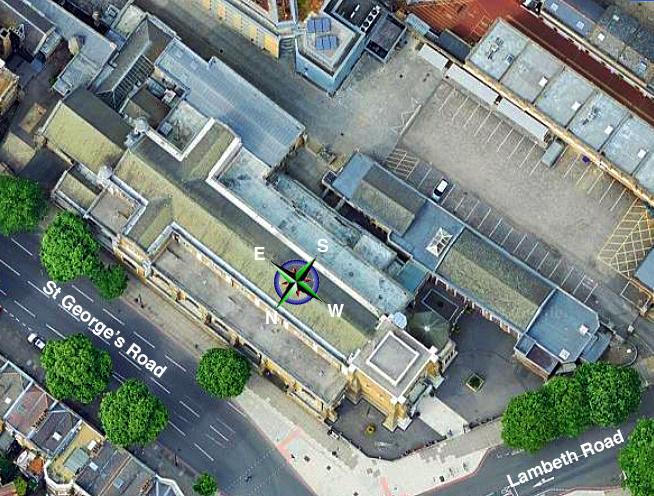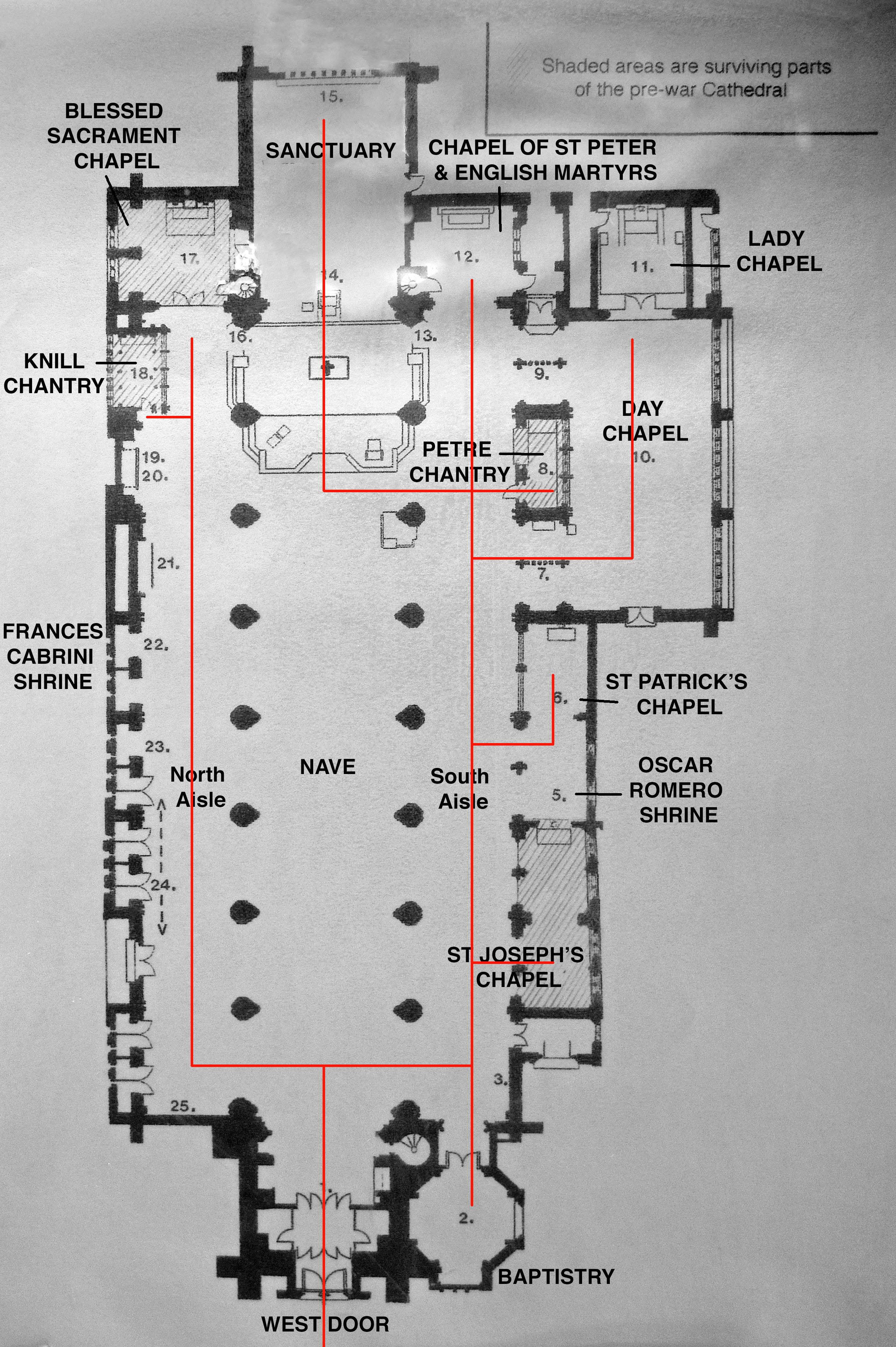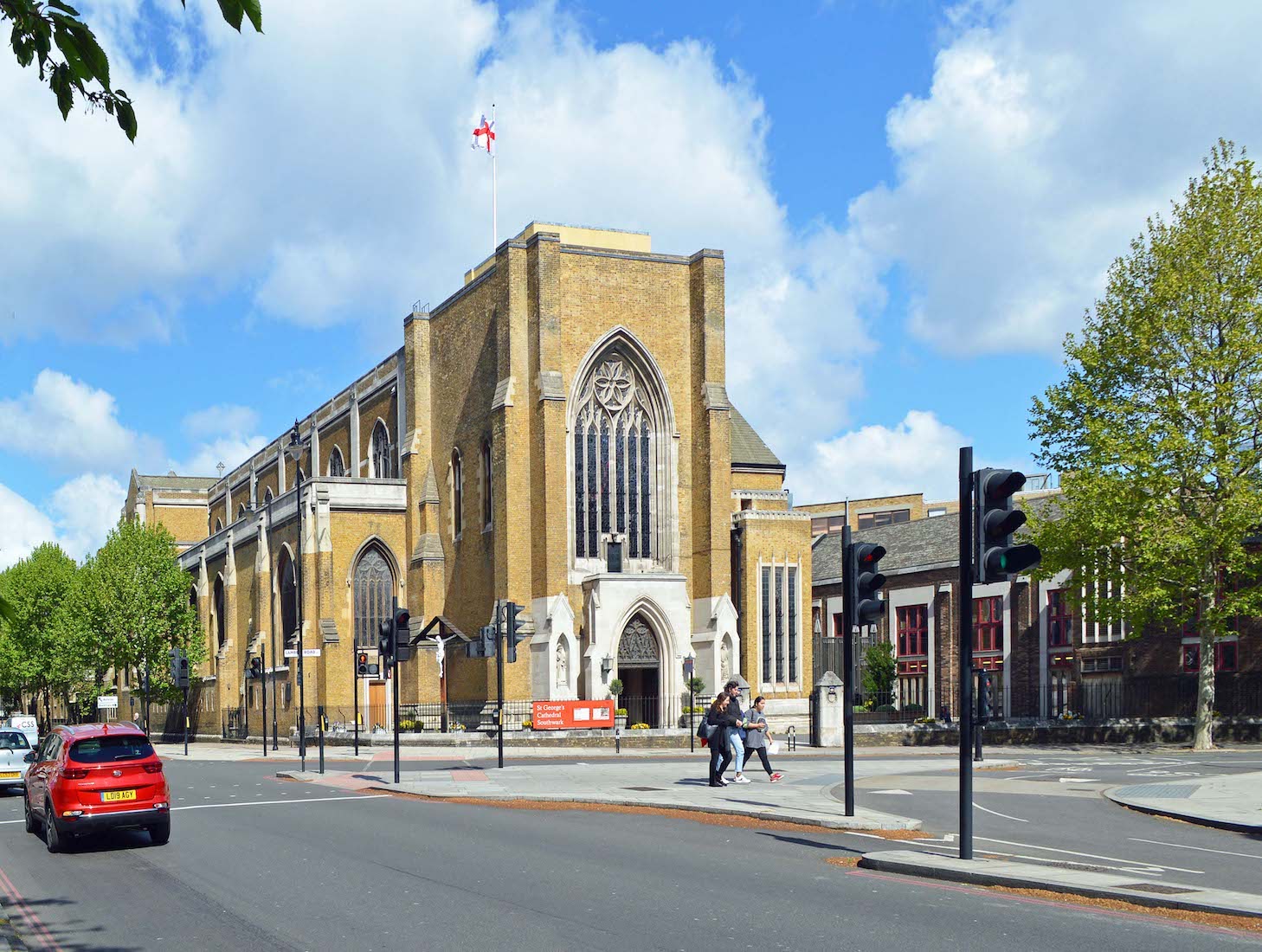ST GEORGE’S CATHEDRAL
SOUTHWARK CATHOLIC
PAUL SCOTT

SATELLITE VIEW
St George’s Cathedral sits at the corner of St George’s Road and Lambeth Road. The satellite view shows that the main axis of the Cathedral is roughly in a geographical northwest – southeast direction – governed by its alignment with St George’s Road. We shall use liturgical directions on this site, for example using East (with a capital E) to denote the sanctuary end. These directions are indicated by the compass rose on the roof of the Cathedral.
We notice that the Cathedral is cruciform in shape with covered side aisles and a massive square tower at the Western end. The baptistry is an extension in the Southwestern corner, and sanctuary and side chapels extend at the Eastern end. The transepts are small and near the Eastern end, and hardly noticeable from inside.
The Cathedral is very constrained by its site and surrounding buildings. So in our exploration of the exterior we shall start at the Northwestern corner, exploring the North and West sides in turn, before entering through the West door.

Our exploration of the interior is indicated by the red lines. Beginning at the West door (bottom) we first take the branch to the left before retracing our steps to follow the right branch to the baptistry, then past various chapels, finishing at the chancel and sanctuary. A brief history of the Cathedral is given below, but if you wish to start the tour, click / tap on START.
You can access intermediate points in the tour by a tap / click on the following links:
NOTE ON MAGNIFYING IMAGES
With this website format the images are large enough for most purposes. If there is a need for greater magnification of an image, go to the identical photo on
https://www.flickr.com/photos/paulscottinfo/albums
and use Command - + (Mac) or Windows - + (Windows).
HISTORY
The Metropolitan Cathedral Church of St George, usually known as St George’s Cathedral, Southwark, is the cathedral of the Roman Catholic·Archdiocese of Southwark, South London and is the seat of the·Archbishop of Southwark.
The cathedral is the Mother Church of the Roman Catholic·Province of Southwark·which covers the Archdiocese of Southwark (all of London south of the·River Thames·including·Kent·and north·Surrey) and the·Dioceses of Arundel and Brighton, Portsmouth, and Plymouth. It is the Metropolitan Cathedral of the Archbishop of Southwark. The building was erected in 1848 and reopened in 1958 after extensive war damage. It is architecturally listed in the initial category of Grade II.
St George’s was built in 1848. Previously, the local Catholic community had used a small chapel on London Road, but the arrival of Irish immigrants in the area necessitated the construction of a larger house of worship. In 1852, it became one of the first four Catholic churches in England and Wales (and the first in London) to be raised to cathedral status since the English Reformation. It was designed by Augustus Pugin, famous for his work with Charles Barry on the design of the rebuilt Houses of Parliament. Pugin was the first person to be married in the church on 10 August 1848 to his third wife Jane.
In October 1920 St George’s was the site of the funeral mass of Irish nationalist Terence MacSwiney, Lord Mayor of Cork, who died on hunger strike in Brixton Prison. John Lavery painted a well-known painting of the funeral.
On the night of 16 April 1941, the Cathedral was hit by an incendiary bomb, starting a fire which destroyed the wooden roof and much else. The rebuilt Cathedral was opened in 1958. Since then it has resumed its role as a focal point in the local community and has played host to many notable visitors, including the Dalai Lama (1998) and Pope John Paul II (1982), the latter being depicted in one of the Cathedral's many fine stained-glass windows.
Easter 2011 saw the partial restoration of the 1958 John Compton organ and the installation in the chancel of the George Pace Choir Stalls, a gift from the Anglican St Alban's Cathedral. The Cathedral has strong links with both the Paderborn Cathedral, North-Rhine-Westphalia, which suffered bombing by the British in the Second World War, and Southwark Cathedral, the local Anglican cathedral.



